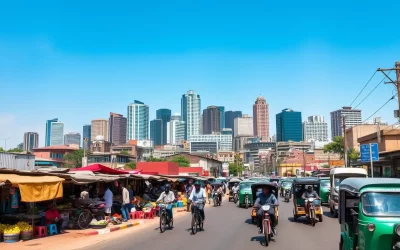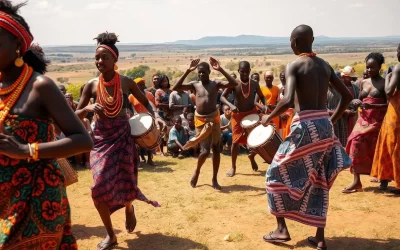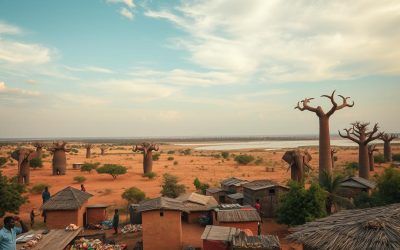✓ Accommodations✓ Flights✓ Rental Cars
South Sudan is a country rich in cultural and linguistic diversity. English serves as the official language, a legacy of its colonial past. It is widely used in government, education, and media, making it a unifying force in the nation.
Beyond English, over 60 indigenous languages are spoken across the country. These languages belong primarily to the Nilo-Saharan family, with Dinka and Nuer being the most prominent. Each language reflects the unique heritage of its speakers, contributing to the nation’s vibrant cultural tapestry.
While English dominates official settings, indigenous languages remain vital in daily life. They connect communities and preserve traditions, even as some face the risk of extinction. Understanding this linguistic landscape offers insight into the heart of South Sudan’s identity.
Overview of South Sudan’s Linguistic Landscape
With over 60 indigenous languages, South Sudan’s linguistic landscape is vast. This diversity reflects the cultural richness of its people. The country’s population, estimated at 15.7 million in 2025, is spread across vast regions, each with its unique language practices.
Geographic and Demographic Context
South Sudan’s geographic expanse plays a key role in its linguistic diversity. The capital, Juba, serves as a hub for cultural exchange. However, rural areas, home to 78.4% of the population, remain deeply connected to indigenous languages.
The population is young, with 41.58% under 14 years old. This demographic trend influences language transmission and education. Regional differences further shape how languages are spoken and preserved.
Multilingualism in a Young Nation
Multilingualism is a defining feature of South Sudan. Over 95% of the population speaks Nilo-Saharan languages, with Dinka and Nuer being the most prominent. This linguistic variety fosters a sense of identity while posing challenges for national unity.
Despite English being the official language, indigenous tongues remain vital in daily life. They connect communities and preserve traditions, even as some face the risk of extinction.
Historical Evolution of Language Policy
The linguistic history of South Sudan is deeply intertwined with its political evolution. From colonial rule to modern governance, language has been a tool of power, identity, and unity. This section explores how historical conflicts and policy decisions have shaped the nation’s linguistic landscape.

Colonial Influence and the Introduction of English
During the 19th century, colonial powers introduced English to the region. This move aimed to establish control and streamline administration. English became the medium for education, governance, and communication, leaving a lasting legacy.
By the early 1970s, half of the secondary schools in key regions conducted classes in English. This policy reinforced its role as a unifying language, even as indigenous tongues thrived in local communities.
Post-Independence Shifts and Constitutional Changes
After gaining independence in 2011, the government faced the challenge of forging national unity. Language policy became a critical tool in this effort. The 2005 constitution established English as the official language, distancing the nation from its past associations.
Periods of war further influenced these decisions. The civil war from 1983 to 2005 highlighted the need for a neutral language to bridge divides. English emerged as a symbol of progress and reconciliation.
“Language is not just a means of communication; it is a marker of identity and a tool for nation-building.”
| Period | Language Policy | Impact |
|---|---|---|
| 19th Century | Introduction of English | Established colonial control |
| 1970s | Bilingual education | Reinforced English’s role |
| 2005 | Constitutional changes | English as official language |
Today, English remains central to governance, education, and media. Yet, indigenous languages continue to thrive, reflecting the nation’s rich cultural heritage.
South Sudan: Official and widely spoken languages
Language plays a dual role in South Sudan, shaping both policy and daily life. While English serves as the official language, it’s the indigenous tongues that truly define the nation’s identity. Over 76 languages are spoken here, reflecting the cultural richness of its people.
English is used in government, education, and media, but it’s not the first language for most South Sudanese. Instead, indigenous languages like Dinka and Nuer dominate daily communication. These languages connect communities and preserve traditions, even as some face the risk of extinction.
The number of native speakers varies widely. For example, Dinka is spoken by millions, while smaller languages like Dongotono and Kuku are on the verge of disappearing. This linguistic diversity highlights the challenges of fostering national unity while respecting local identities.
“Language is more than words; it’s the heartbeat of a community.”
Understanding this linguistic landscape offers insight into the heart of South Sudan. It’s a place where official designations meet the lived experiences of its people, creating a unique blend of tradition and modernity.
Diversity of Indigenous Languages
The linguistic tapestry of South Sudan is a testament to its cultural richness. Over 60 indigenous languages are spoken here, each representing a unique heritage. This diversity is a defining feature of the nation’s identity, connecting communities and preserving traditions.
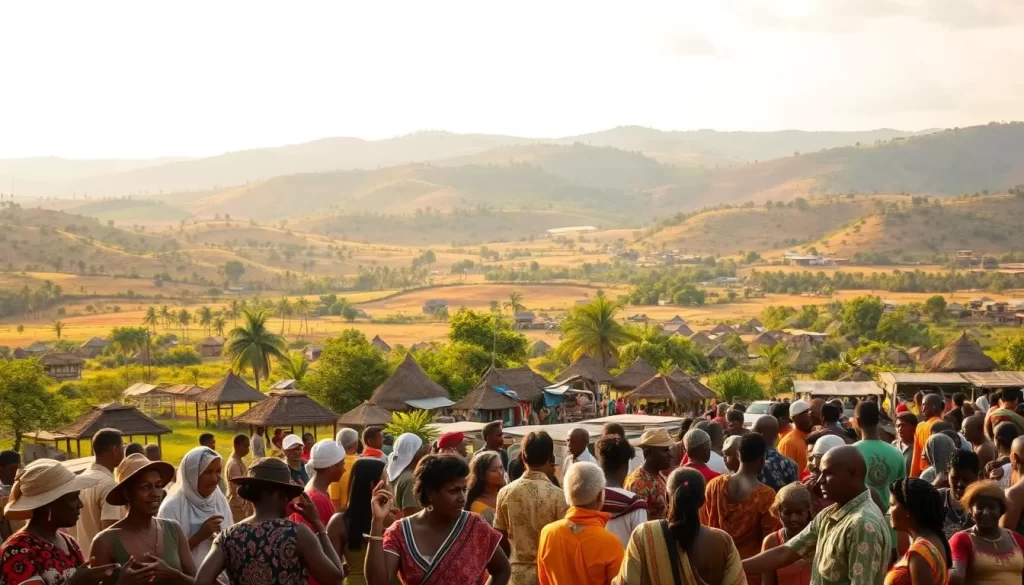
Nilo-Saharan Language Family and Beyond
Most of these languages belong to the Nilo-Saharan language family. Dinka and Nuer are the most widely spoken, with millions of speakers each. Other prominent languages include Zande and Bari, which also have significant speaker populations.
While the Nilo-Saharan family dominates, other linguistic groups are present. These include Afro-Asiatic and Niger-Congo languages, adding to the region’s complexity. Each language reflects the history and culture of its speakers, creating a vibrant linguistic mosaic.
Preservation Challenges and Endangered Languages
Despite their cultural importance, many indigenous languages face preservation challenges. Some, like Mittu and Togoyo, have already become extinct. Others, such as those in the Bahr Ghazal region, are at risk of disappearing due to declining use among younger generations.
Local initiatives are working to safeguard these languages. Efforts include developing educational materials and promoting cultural events. These actions aim to ensure that linguistic heritage thrives amid modernization pressures.
“Every language lost is a piece of history erased.”
Understanding this linguistic landscape offers insight into the heart of South Sudan. It’s a place where tradition meets modernity, and every speaker plays a role in preserving their heritage.
English as the Official Language
English has become a cornerstone of unity in a nation marked by linguistic diversity. Introduced during colonial times, it remains the primary language in government, media, and formal education. This choice reflects a deliberate effort to foster national cohesion and progress.
Role in Government, Media, and Education
In government, English is the medium for official communication and policy-making. It ensures clarity and consistency across diverse regions. Media outlets also rely on English to reach a broader audience, making it a key tool for information dissemination.
Education plays a crucial role in reinforcing English’s prominence. Most schools and universities use it as the medium of instruction. This approach has transformed the education system, requiring new syllabi and learning materials to be designed in English.
Proficiency in English opens doors to employment opportunities, particularly in government and private sectors. Graduates with strong English skills often advance to leadership roles, such as head teachers or supervisors.
Impact on National Identity
English’s adoption has significantly shaped national identity. It serves as a neutral language, bridging divides in a country with over 60 indigenous tongues. This unifying role is especially important in a young nation striving for stability and growth.
Language instruction in schools is designed to promote national integration. By learning English, students gain access to global knowledge while contributing to their country’s development.
“Language is not just a tool for communication; it’s a foundation for unity and progress.”
Modern examples from media and policy documents highlight English’s lasting impact. It continues to attract international support for developmental projects, further solidifying its role as a unifying force.
Juba Arabic and Other Non-Indigenous Influences
In the heart of East Africa, Juba Arabic stands as a bridge between diverse communities. This pidgin language, spoken by over 1 million people, serves as a lingua franca in the capital city of Juba. Its simplified grammar and practical usage make it a vital tool for communication among different ethnic groups.
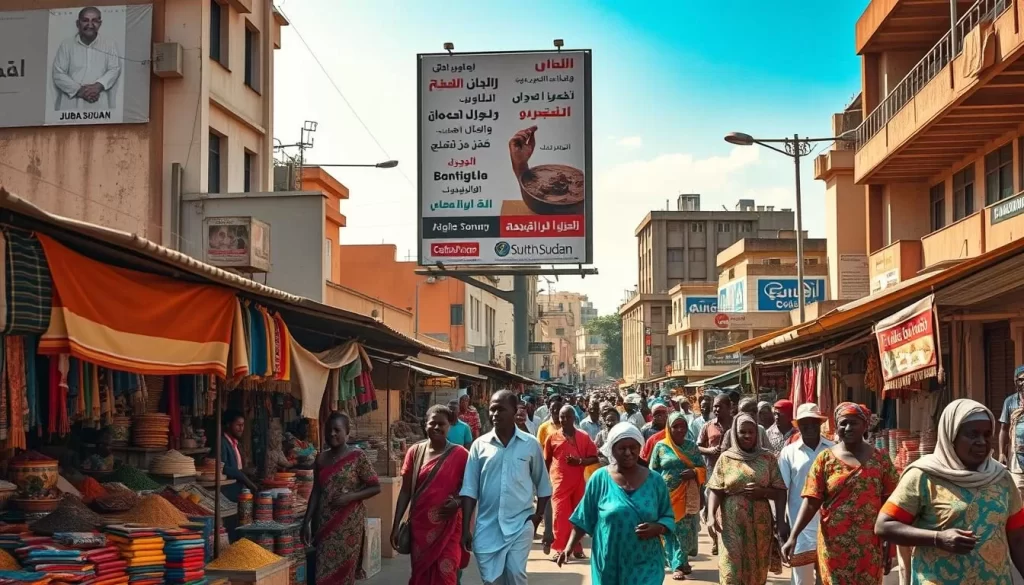
Juba Arabic emerged in the 19th century among descendants of Sudanese soldiers. Over time, it evolved into a shared medium for trade, social interaction, and daily life. Today, it’s a testament to the region’s ability to adapt and create solutions for communication barriers.
Pidgin Forms and Lingua Franca Status
As a pidgin language, Juba Arabic is not typically passed down as a first language. Instead, it’s learned as a second language by over 1.2 million people. This makes it a unique linguistic phenomenon in South Sudan, where it bridges gaps between indigenous and non-indigenous groups.
The East African Community’s influence has further shaped language usage in the region. Ties to neighboring countries have introduced new dynamics, enriching the linguistic mosaic. Juba Arabic, in particular, reflects this blend of local and regional elements.
“Language is the thread that weaves communities together, even in the most diverse settings.”
Real-world examples highlight its importance. In markets, schools, and public spaces, Juba Arabic fosters social cohesion. It’s a reminder that language is more than words—it’s a tool for unity in a multicultural society.
For more insights into the linguistic diversity of the region, explore the Languages of South Sudan. To delve deeper into the origins of Juba Arabic, visit Juba Arabic.
Challenges Facing Indigenous Language Instruction
The future of indigenous languages in South Sudan faces significant hurdles. Younger generations are less likely to learn these languages at home or in school, leading to a decline in intergenerational transmission. This shift threatens the survival of many linguistic traditions.
In schools, indigenous languages often lack support. The education system prioritizes English, leaving little room for local tongues. This creates a gap where children lose touch with their cultural heritage.
Decline in Intergenerational Transmission
Language transmission from parents to children is weakening. Many families now speak English or Arabic at home, reducing exposure to indigenous languages. This trend is especially noticeable in urban areas.
In rural regions, the situation is slightly better. However, even here, younger children are increasingly drawn to dominant languages for better opportunitiesq>. This shift is reshaping the linguistic landscape.
Community Initiatives for Revival
Community-driven projects are stepping up to address these challenges. Local groups are creating educational materials and organizing cultural events to revive language practices. These efforts aim to reconnect children with their roots.
One example is the use of storytelling workshops. Elders share traditional tales in indigenous languages, engaging younger audiences. Such initiatives foster pride and interest in cultural heritage.
“Every language preserved is a victory for cultural diversity.”
| Initiative | Focus | Impact |
|---|---|---|
| Storytelling Workshops | Engaging children | Increased interest in heritage |
| Language Classes | Teaching indigenous languages | Improved language retention |
| Cultural Festivals | Celebrating traditions | Strengthened community bonds |
For more insights into these efforts, explore the challenges and strategies in multilingual education. These projects highlight the importance of preserving linguistic diversity in South Sudan.
Future Trends in Language Adoption and Policy
Language trends in South Sudan are shifting with global and regional influences. Over the next few years, policy discussions hint at new adoptions, such as Swahili, to foster regional integration. This move aligns with efforts to strengthen ties across East Africa.

Prospects for Swahili and Regional Integration
Swahili is gaining traction as a unifying language in the area. Its adoption could enhance communication and trade across borders. This trend reflects a broader push for cultural and economic collaboration in the region.
Data from recent years shows increasing interest in Swahili education. Schools and institutions are exploring ways to integrate it into their curricula. This shift could elevate its level of use in daily life and formal settings.
Digital Innovation in Language Instruction
Digital tools are transforming how languages are taught in South Sudan. Online platforms are making learning more accessible, especially in remote areas. This innovation is crucial for preserving indigenous languages and improving education.
Partnerships with East African countries are driving technological advances. For example, mobile apps and e-learning modules are being developed to deliver spoken South Sudan content. These tools are designed to engage learners and enhance proficiency.
“Digital innovation is not just a tool; it’s a bridge to preserving our linguistic heritage.”
For more insights into these trends, explore the future of indigenous languages in South. These developments highlight the importance of adapting to global changes while honoring local traditions.
Cultural Significance and Identity Through Language
Language is the heartbeat of South Sudan’s cultural identity. It’s more than a tool for communication—it’s a reflection of heritage, values, and belonging. For many, it’s a way to connect with their roots and pass down traditions to future generations.
Language as a Marker of Community and Heritage
In South Sudan, language plays a pivotal role in defining family traditions and personal identity. It’s how stories, customs, and values are shared across generations. For example, the Dinka and Nuer communities use their native tongues to teach children about their history and roles in society.
Language also reflects the state’s values and collective memory. It’s a living testament to the struggles and triumphs of the person who shaped the nation. Through proverbs, songs, and oral histories, South Sudanese preserve their cultural heritage.
For many, language is a bridge to their past and future. It strengthens bonds among family members and communities. In rural areas, where 78.8% of the population lives, indigenous languages remain central to daily life.
“Language is not just a means of communication; it’s the soul of a community.”
Efforts to preserve these languages are crucial. With over 60 ethnic groups and more than a hundred local languages, South Sudan’s linguistic diversity is a treasure worth protectingq>. Learn more about this rich cultural tapestry in our exploration of South Sudan’s cultural diversity.
| Aspect | Role of Language | Impact |
|---|---|---|
| Family Traditions | Transmits values and customs | Strengthens generational bonds |
| State Identity | Reflects collective memory | Fosters national unity |
| Community Bonds | Connects individuals | Preserves cultural heritage |
Understanding the cultural significance of language offers insight into the heart of South Sudan. It’s a place where every word carries the weight of tradition and the promise of continuity.
Conclusion
The linguistic journey of this nation reflects its resilience and cultural depth. From the western bahr ghazal communities to the broader african community, regional influences have shaped its identity. English, as the official language, serves as a unifying force, yet indigenous voices remain vital in daily life.
Language is more than a tool for communication—it’s a part of what makes this country unique. As you explore South Sudan’s cultural diversity, you’ll see how it bridges tradition and modernity. The future of language adoption here is a shared legacy for million persons in the region.
In a world of constant change, preserving these linguistic treasures ensures that the heart of this nation continues to beat strong.
The above is subject to change.
Check back often to TRAVEL.COM for the latest travel tips and deals.


